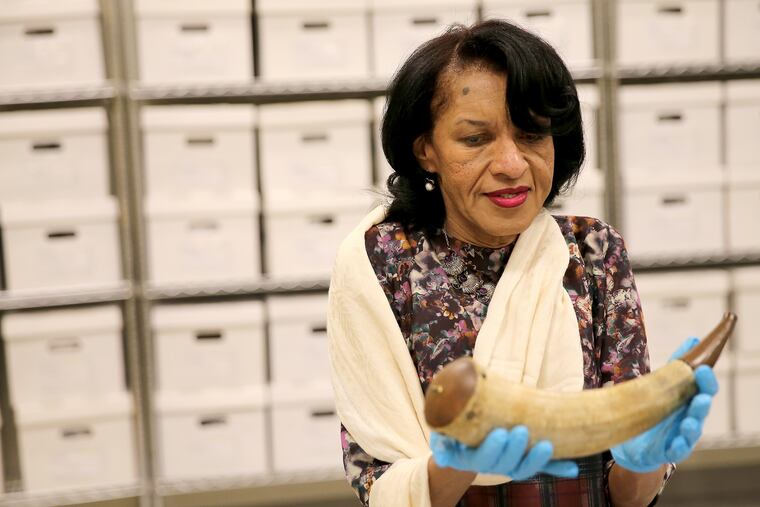Philly museum thinks it has the only surviving relic of its type from a slain African American colonial soldier
The Museum of the American Revolution will put on display Friday the delicately inscribed powder horn carried by Gershom Prince, killed in battle in 1778.

When Philip Mead, chief historian and curatorial director at the Museum of the American Revolution, looked down at the gently curving carved powder horn Wednesday, he saw “African American history, Native Americans, the American Revolution, the stories of British and Loyalist soldiers — all converging on this one spot, the Battle of Wyoming, that we hardly know anymore.”
When Denise Dennis, founding president of the Dennis Farm Charitable Land Trust in Susquehanna County, looked at the horn she thought of all those things, but most remarkably, she also saw family, resilience, and persistence.
“It’s been part of my life and consciousness as long as I can remember,” she said, gently holding the horn. “It’s part of my personal history and speaks to the closeness and intimacy of family.”
Mead and Dennis, standing in the workroom of the museum, were both looking at the cream-colored powder horn delicately inscribed and decorated by Gershom Prince, a free African American and Dennis’ ancestor, slain in the bloody, but not widely known, Battle of Wyoming, the only black soldier to die there on that grim day, July 3, 1778.
More than 300 colonial soldiers were killed in the battle, in northeastern Pennsylvania’s Wyoming Valley, near Wilkes-Barre, as the outnumbered Continental Army vainly sought to fend off attacks from British and Loyalist forces and their Iroquois allies.
On Friday, Gershom Prince’s utterly unique powder horn, found on his body after the fighting, will go on exhibit at the museum, through the end of the year. It is believed to be the only surviving powder horn of a slain African American Revolutionary War soldier.
“It’s indispensable, irreplaceable, and an invaluable national treasure to us,” Mead said.
For Dennis, seeing the horn being prepared to go on display in Philadelphia is a deeply moving experience. After it was removed from Prince’s body, it was returned to his family. Generation after generation passed it down. In the 1950s, the family donated it to the Luzerne County Historical Society, which has lent it to the museum.
“What it means to me is that I am very much connected to the history of the country in a very, very personal way,” said Dennis, who is steward of the Dennis Farm, a 153-acre site on the National Register of Historic Places, acquired by her great-great-great-great-grandfather Prince Perkins, who also fought in the Revolutionary War and was freed for his service.
Prince Perkins was Gershom Prince’s nephew. The family has owned the farm since 1793.
» READ MORE: The fascinating history of the Dennis Farm
Not surprisingly, much is unknown about Gershom Prince. He was probably born in Connecticut around 1733, and when he died, he was probably a free man.
He chose to be a soldier, fighting first in the French and Indian War, which racked the countryside from 1754 to 1763 and set the stage for subsequent revolutionary unrest.
It was during that earlier conflict that Prince acquired and delicately incised his powder horn, which reads “Prince Negro His Horn.” Flowers and vines, birds, a boat, and simple small houses decorate the surface, all delicately drawn, a record of Prince’s landscape.
The place of the carving, Crown Point, and the date – “Sept. ye 3rd Day 1761” – are also clearly carved. With a flourish, Prince added a warning: “Steal not for fear of shame.”
“It’s the only French and Indian horn from a person of African American heritage, personal horn, that I am aware of,” said Mead. “It’s so impossibly rare.
“People of African heritage were 25 percent of the population in 1776, with about 90 percent enslaved. So virtually any object from 18th-century America has an African American history,” he said, because African Americans were "making it and using it and touching it. But what’s so rare is to have an object with a personal identification.”
Dennis, turning the horn over on its side, said: “It’s signed. It’s clearly signed.”
Mead nodded his head, noting that the horn was a “clearly valued” possession and conveyed its owner’s identity.
“Gershom Prince is telling you he’s a soldier,” Mead continued. “He had virtue, meaning he was willing to put his own self aside for the community. He was literate at a time when that was rare for African Americans, even in the north, where slavery was already under attack and criticism.
“He was refined,” the historian continued. "He had an elevated artistic sensibility informed by the current modes of fashion. Those flowers on there echo the crewel work on silk waistcoats and on the bedding of middle-class households. They were a demonstration of his gentility.
"All of that together, combined in an object that’s a pretty rudimentary thing to begin with — a cow’s horn — means a lot and was passed on from generation to generation.”
Dennis was silent for a moment.
“And this can change perceptions about race in this country, about the contributions of African Americans and our basic humanity,” she said. “The signature. The artistry. The sacrifice — it’s all there, so far back.”